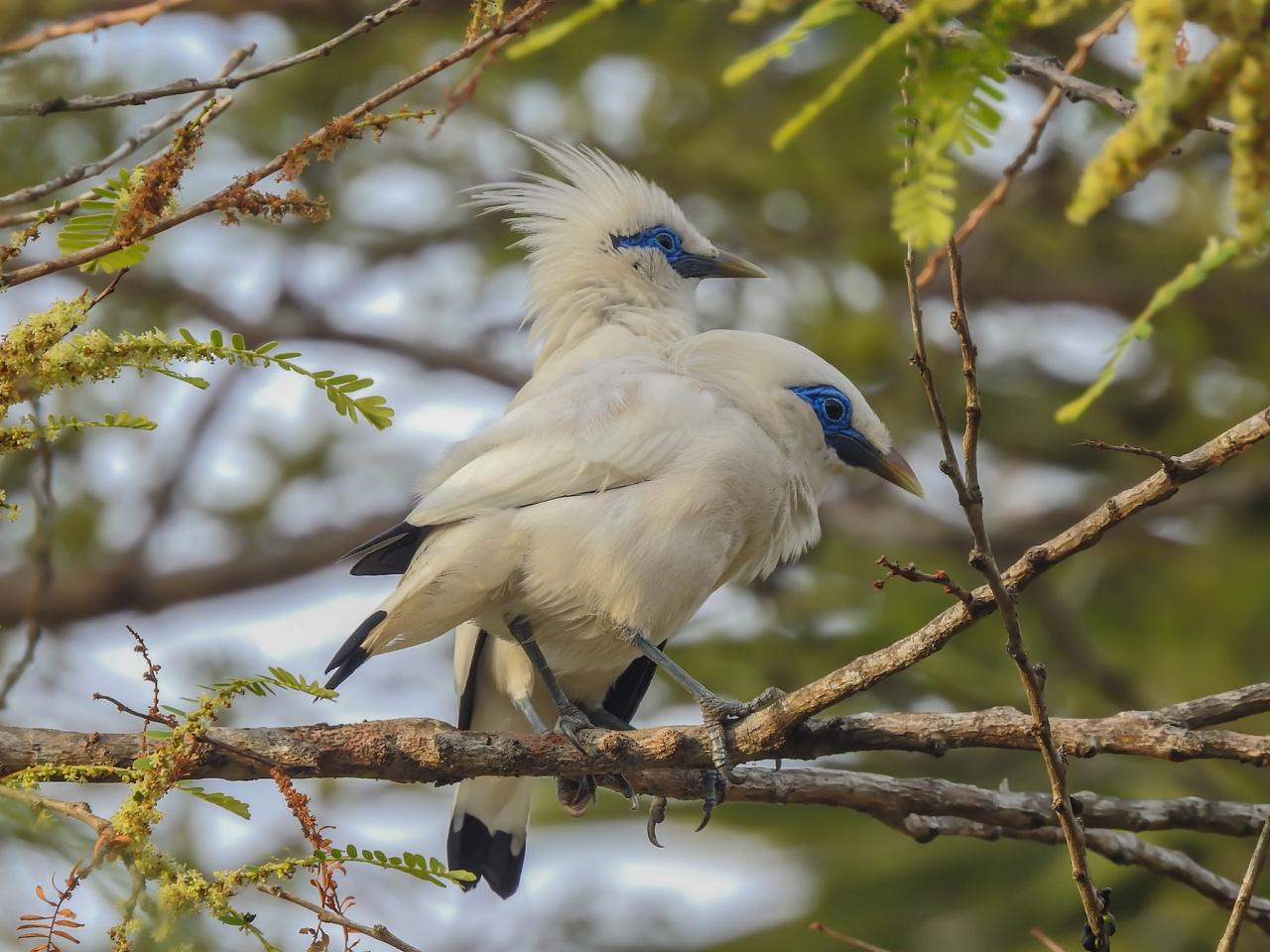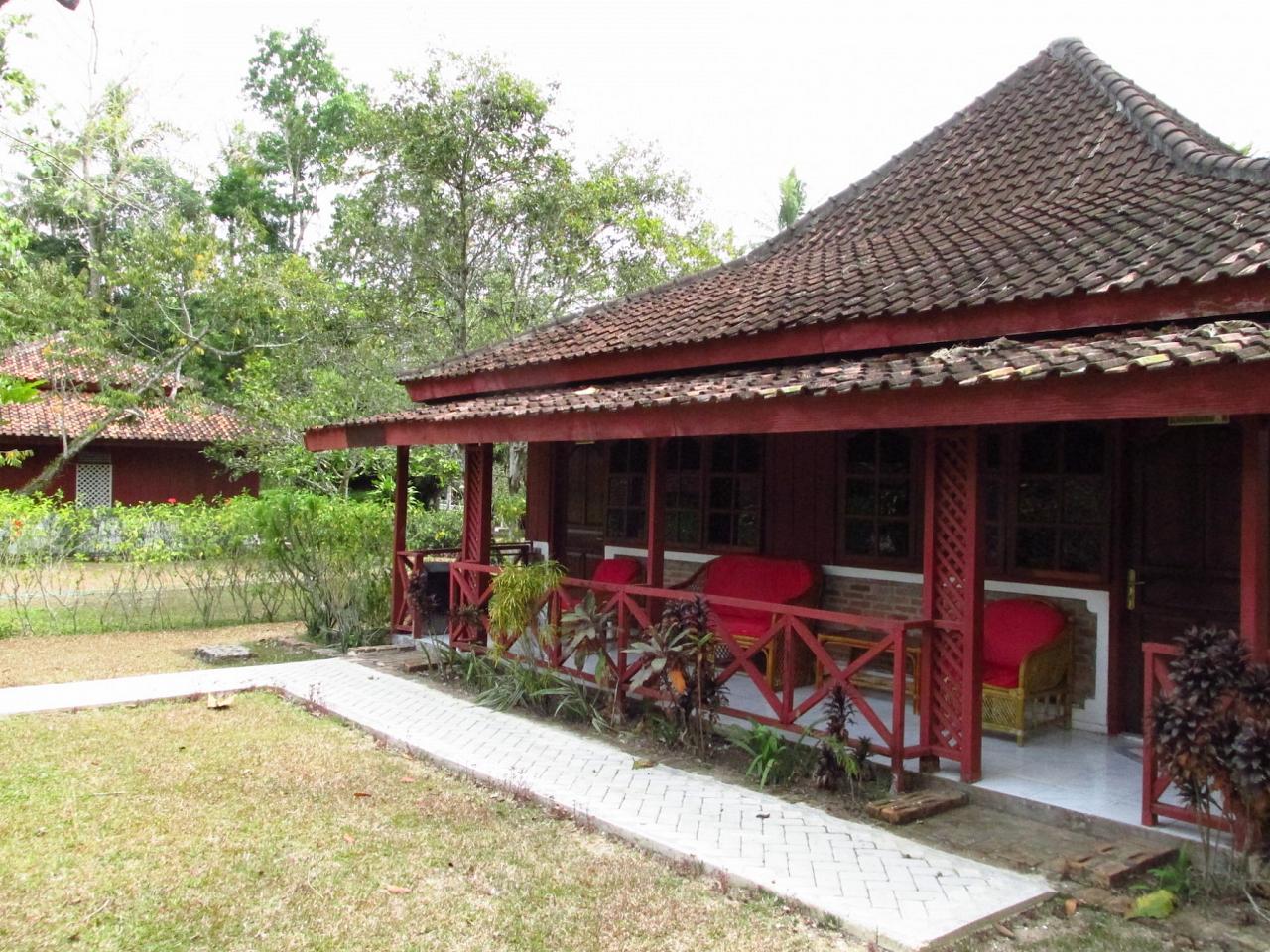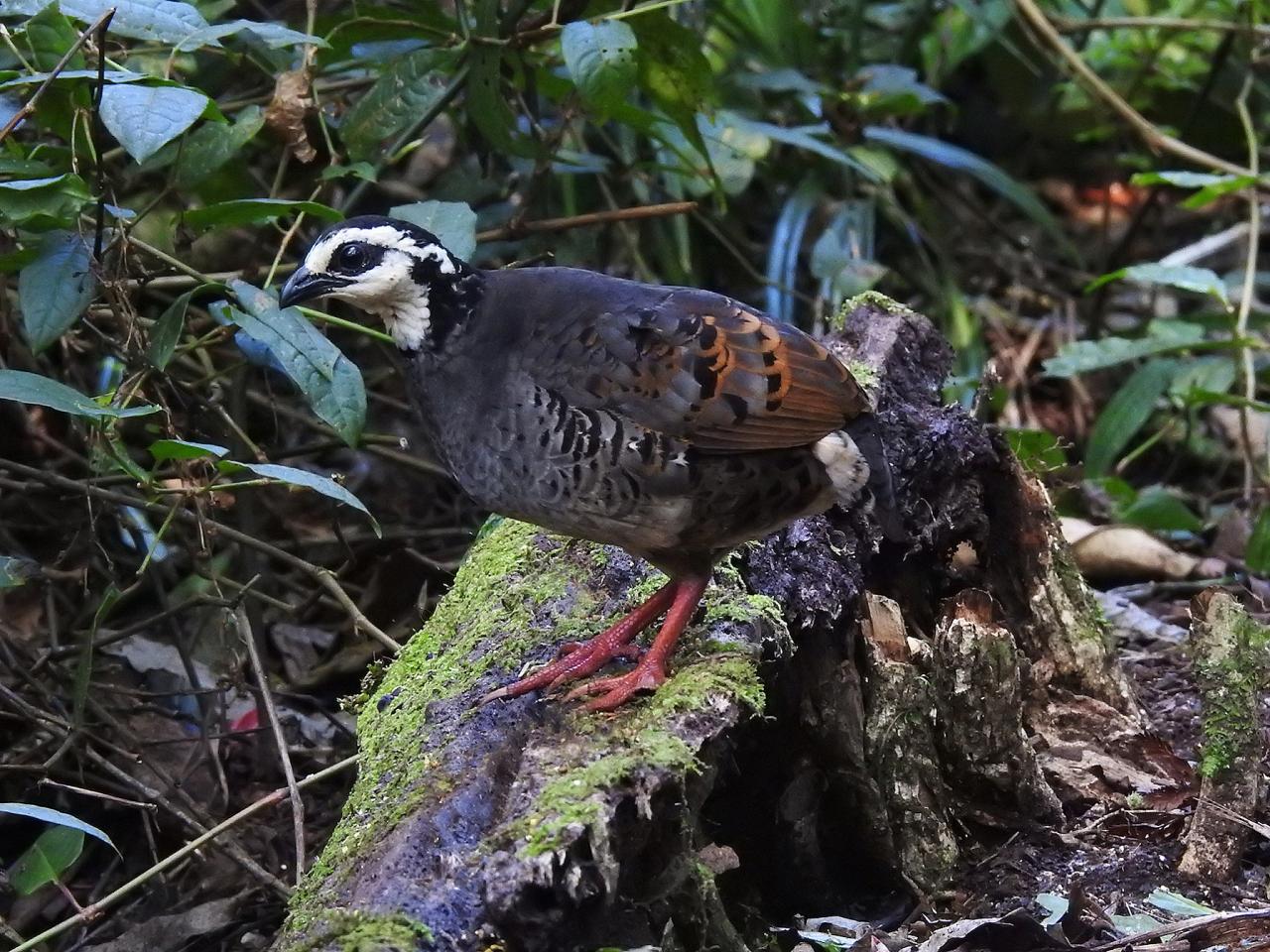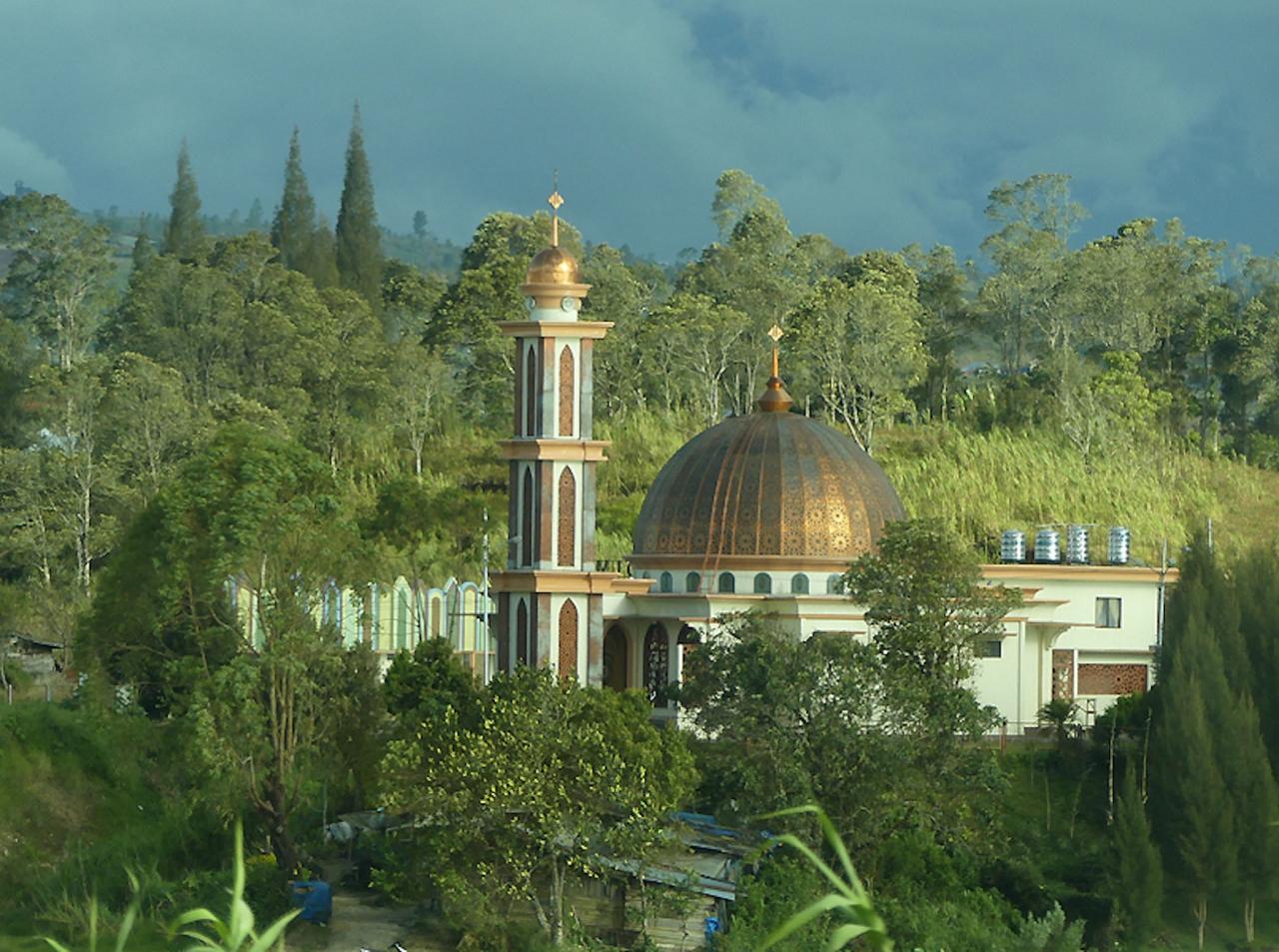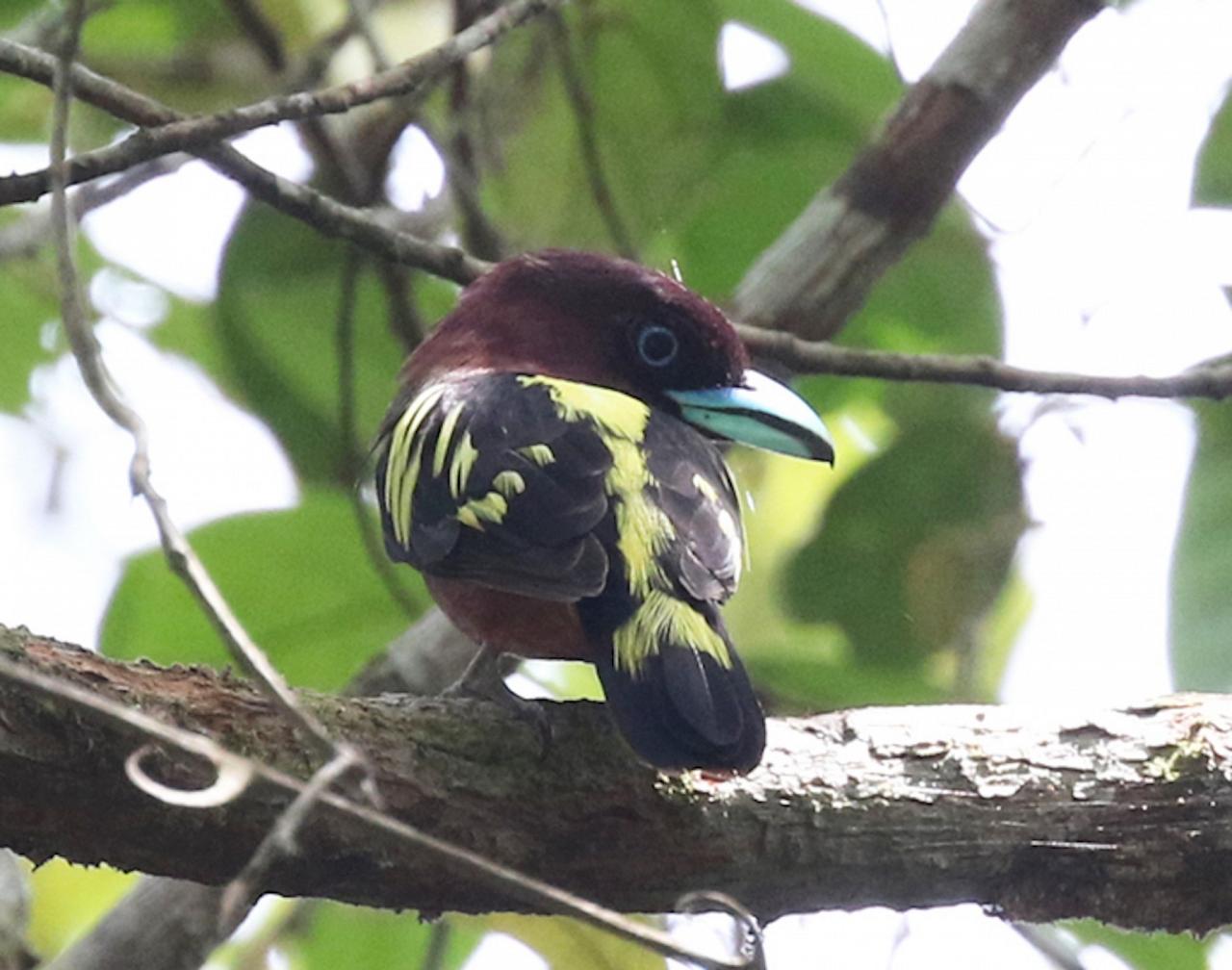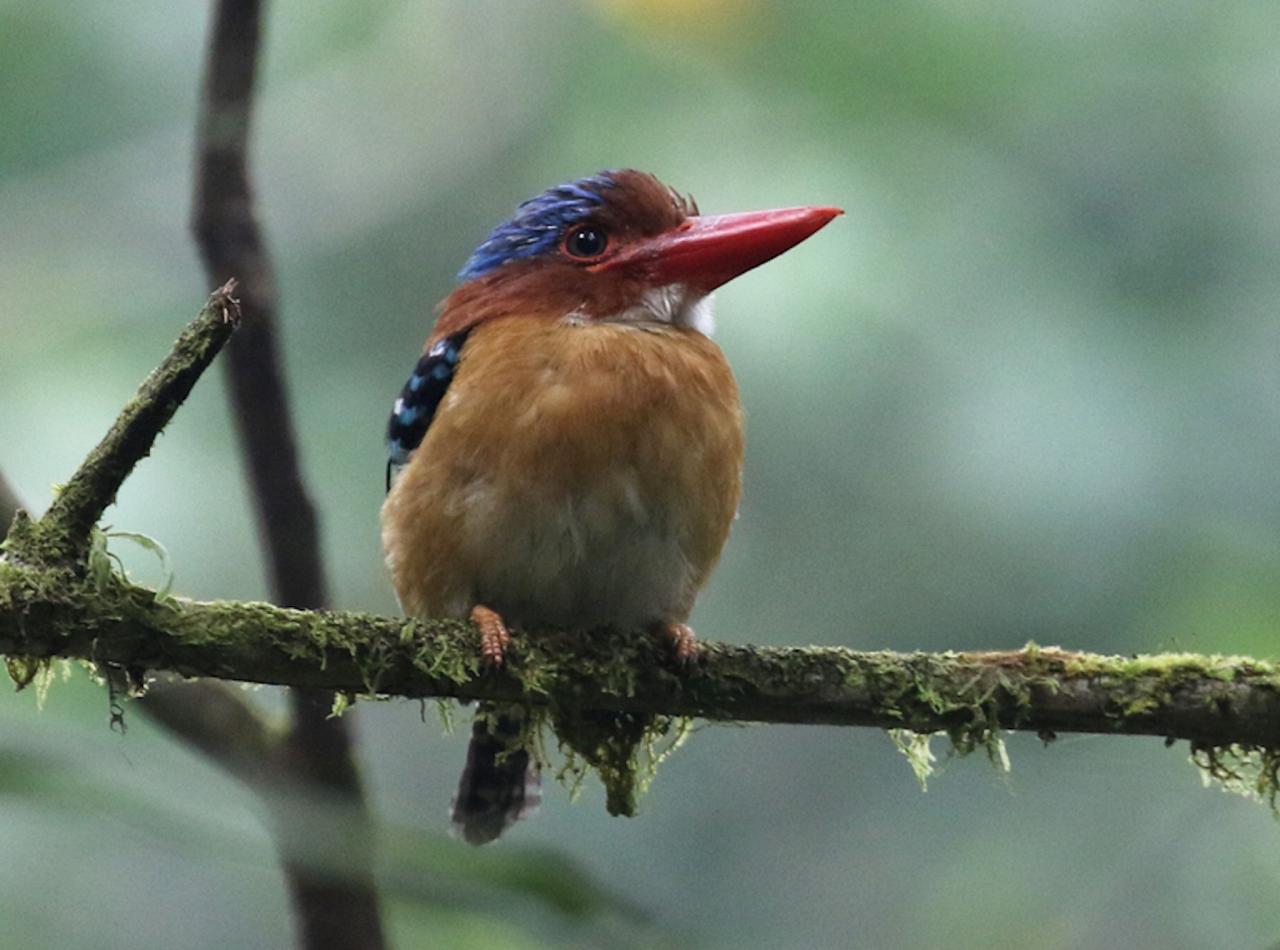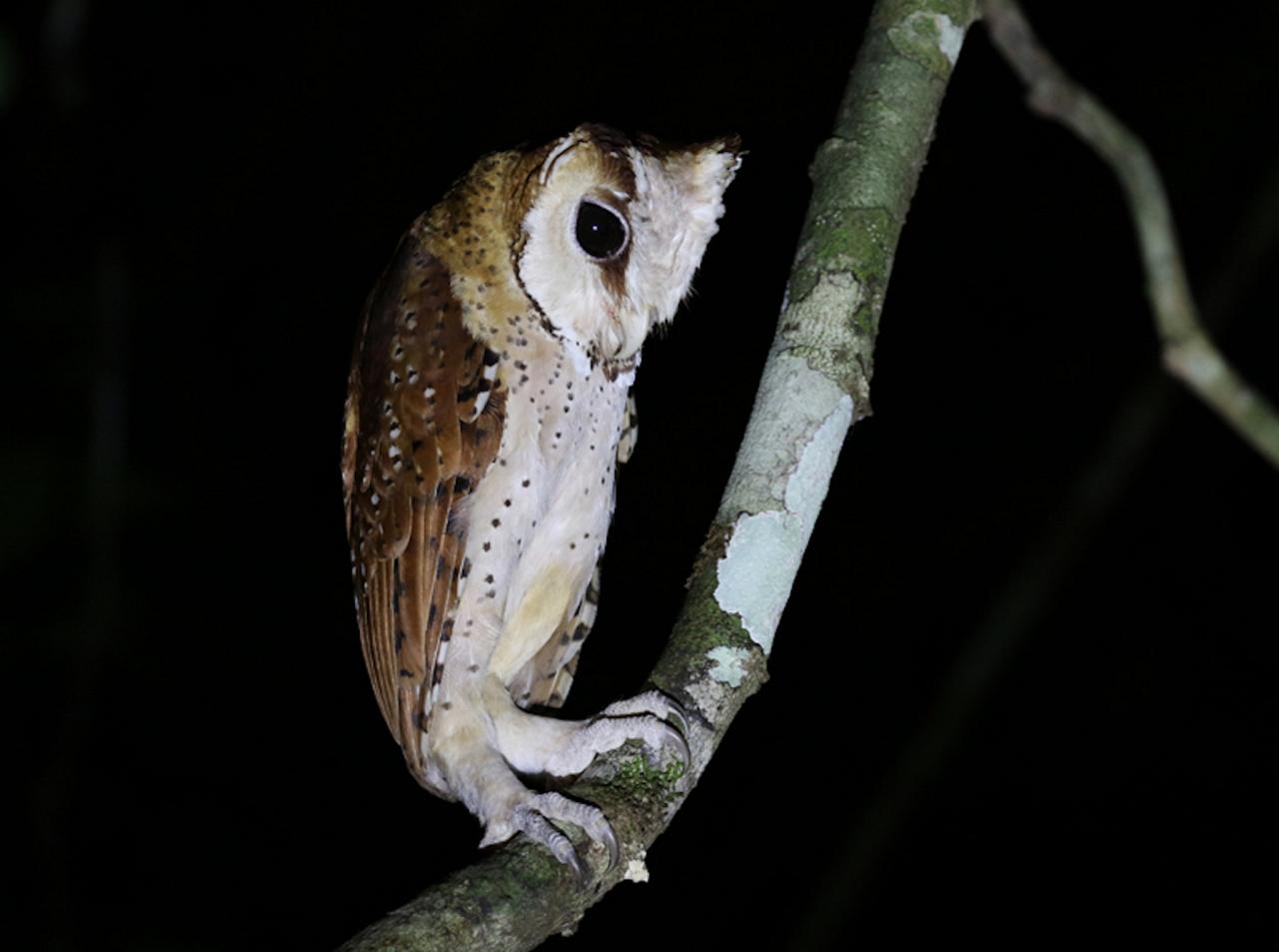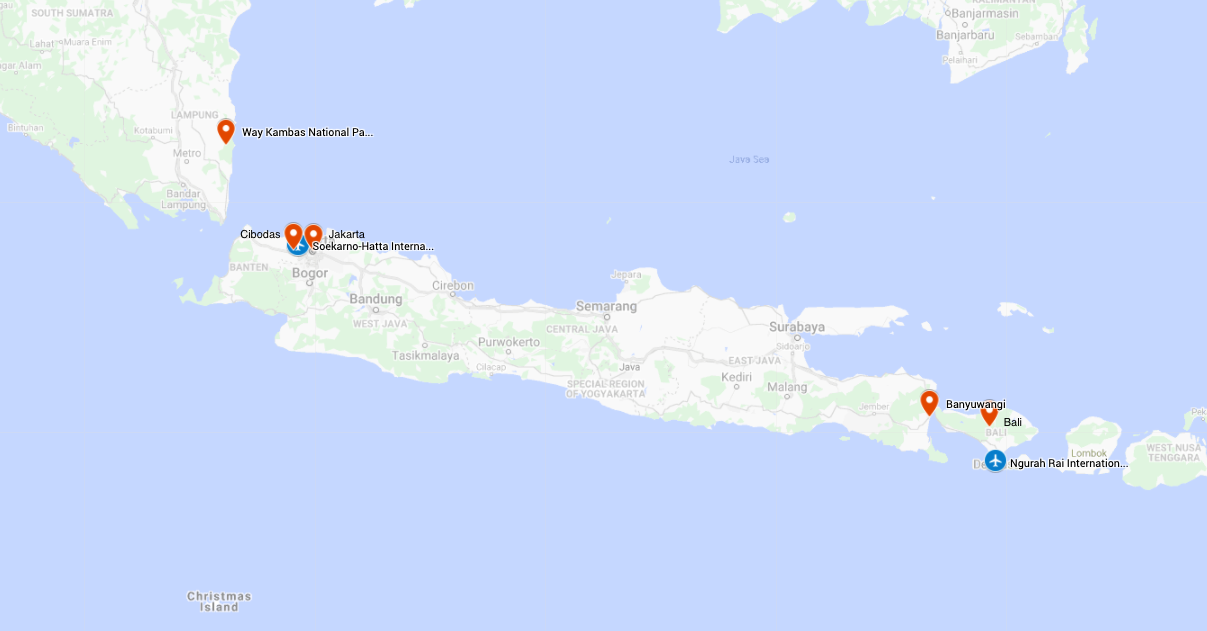- Overview
- Full Itinerary
- Photo Gallery
- Costing
- Travel Details
- Trip Reports
- Guide
- Map
- Know Before You Go
Join Naturalist Journeys on an incredible adventure to Indonesia, where we seek out the region’s most colorful, jewel-like birds with our trusted local guide, Nick Upton.
Visit Way Kambas National Park for specialties like Banded Broadbill and for excellent night birding. Look for waterbirds, shorebirds, and more in Jakarta Bay. Visit two different botanic gardens for an introduction to local flora as we search for Yellow-throated Hanging Parrot. Explore the forested slopes of Gunung Gede, a prized birding location. Explore Bali Barat National Park, picture perfect and home of the stunning and endangered Bali Myna.
Naturalist Journeys is excited to offer this NEW! Indonesia birding and nature tour.
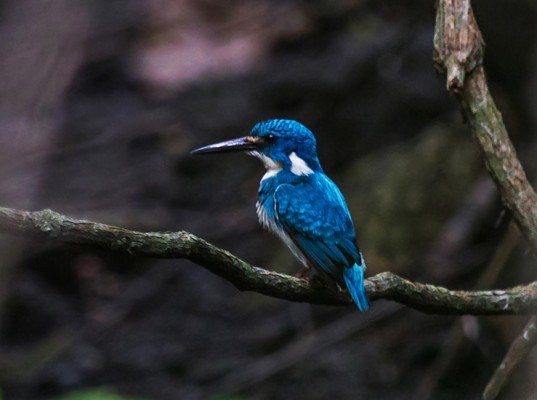
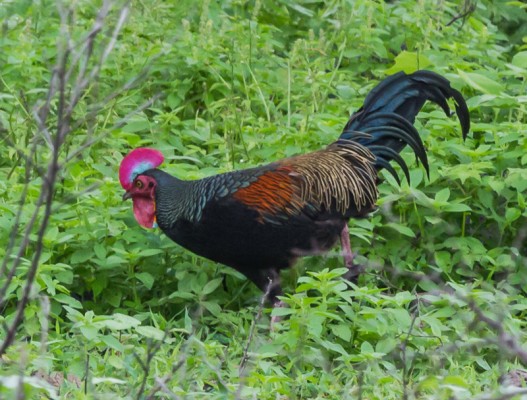
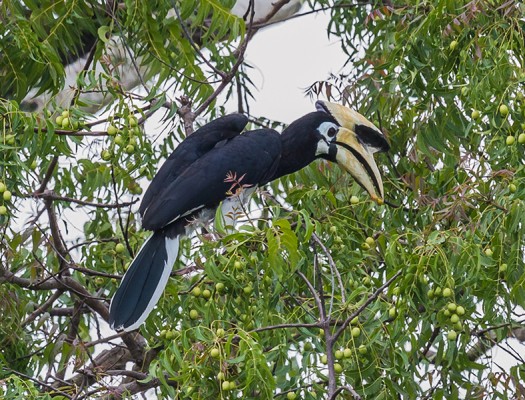
Tour Highlights
- Explore Sumatra’s Way Kambas NP for beautiful pittas, exceptional night birds, and myriad woodpeckers
- Cruise Jakarta Bay for Sunda Coucal and rare Black-winged Myna, as well as waders like Javan Pond and Purple Herons
- See rare Christmas Island Frigatebird before exploring Pulau Rambut island reserve for rarities like Milky Stork
- Visit Cibodas Botanical Gardens with lovely views of the volcanic summits that form Gunung Gede-Pangrango National Park
- Look for the super cute Pygmy Cupwing and Sunda Blue Robin, as well as Chestnut-bellied Partridge at in Gunung Gede
- Search Gunung Ijen for endemic White-faced Partridge and stunning Pink-headed Fruit Dove
- See Orange-breasted Trogon and Banded Kingfisher in Baluran National Park, as well as Javan Banded Pitta (bird of the trip, perhaps!)
- Take in Bali Barat NP, so picturesque; it’s here that we search for Bali Myna
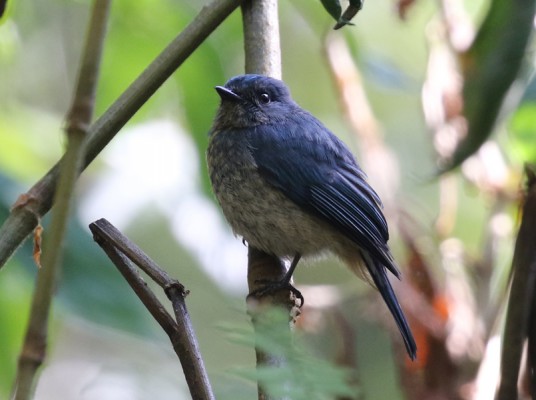
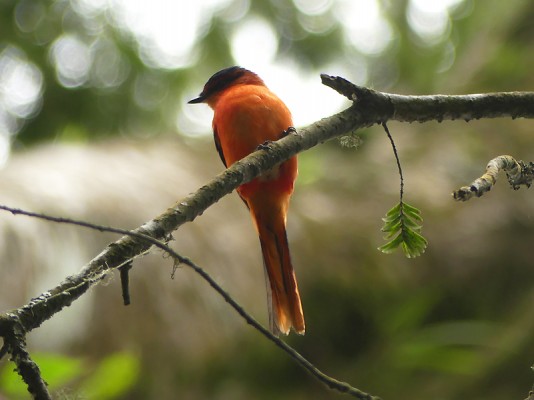
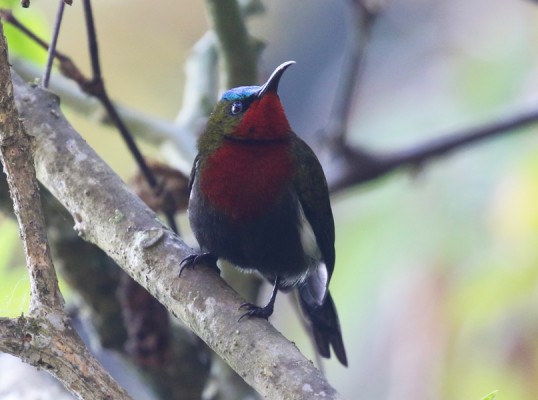
Trip Itinerary
Itineraries are guidelines; variations in itinerary may occur to account for weather, road conditions, closures, etc. and to maximize your experience.

Tues., Sept. 14: Arrivals
Welcome to Indonesia! Please plan to arrive no later than today. You are met on arrival at the Soekarno-Hatta International airport and driven the short distance to our comfortable hotel. We get together officially for dinner tonight at 6:30 PM in the hotel restaurant. We have a pre-trip briefing, get to know each other and our guide, and prepare for a grand trip to come.
Accommodations at Ibis Styles Airport Hotel, Jakarta (D)

Wed., Sept. 15: Bandar Lampung, Sumatra | Satwa Lodge
After an early breakfast at our hotel we take a quick 45-minute flight from Jakarta to the city of Bandar Lampung in southern Sumatra where we are met by our drivers and local guide for the next five days. The two hour drive to Satwa Lodge takes us through the outskirts of Bandar Lampung then through rice fields and villages before we arrive in time to check in and have lunch at our lodge.
We settle in, then head out for a late afternoon birding session where we try to find some of the star birds for a big start to our trip; Malayan Banded Pitta and White-winged Duck are both birds that we have a good chance of finding on our first day. This evening we stay out for some night birds; Way Kambas is one of the best locations for this activity in Southeast Asia. The incredible Large Frogmouth and Bonaparte’s Nightjar are both birds that we can expect to find.
Accommodations at Satwa Camp, Way Kambas (B,L,D)
Thurs., Sept. 16 – Sat., Sept. 18: Exploring Way Kambas National Park
We have three full days to enjoy some of the best lowland birding that Southeast Asia has to offer. As the previous evening should have demonstrated, for anyone who enjoys night birding this is a must-visit location and we have the time to make a couple of evening excursions to look for birds such as Sunda Frogmouth, Malaysian Eared Nightjar, Brown Boobook, Reddish Scops Owl, Sunda Scops Owl, Gould’s Frogmouth, Large-tailed Nightjar, with the crowning glory being Oriental Bay Owl. A high level of success is usually enjoyed with these birds but patience and a little persistence is always needed; at least one of these species has the knack of making life a bit hard on each trip.
The quality forest here is home to a wide range of species that are rare in much of their range but here the ground-dwelling Crested Fireback is fairly abundant and we have a real chance of locating parties of amazing Crested Partridge or even Great Argus. Malayan Banded Pitta is a jewel of the forest floor and we have time to make every effort to ensure everyone gets a good view of this stunner. Woodpeckers are well-represented at Way Kambas and we are likely to see many species including Olive-backed Woodpecker, Buff-necked Woodpecker, Orange-backed Woodpecker, White-bellied Woodpecker, Banded Woodpecker, and Buff-necked Woodpecker as well as the tiny, hammer-headed Buff-rumped Woodpecker and Grey-and-buff Woodpecker. Believe it or not this is not an exhaustive list of the woodpeckers we are likely to see here!
Colorful birds like Banded Broadbill, Blue-crowned Hanging Parrot, Rufous-collared Kingfisher, Diard’s Trogon, Banded Kingfisher, Red-bearded Bee-eater, Raffles’s Malkoha, Scarlet-rumped Trogon, Dark-throated Oriole, Cerulean Kingfisher, and Red-naped Trogon are exactly the sort of species that visiting birders want to see and we have a good chance of finding all of these. Nobody forgets the incredible Green Broadbill once they have seen it!
Of course it is not all about these colorful birds and we do find a wide range of less showy but no less intriguing birds such as Ferruginous Babbler, endemic Sumatran Babbler, Grey-chested Jungle-flycatcher, Chestnut-rumped Babbler and the strangely-named Fluffy-backed Tit-babbler which can put on an amazing show when proclaiming their territory.
Our visit to Way Kambas includes a boat trip along the river through the forest giving us a nice, relaxing way to locate more of Way Kambas’ birds; perhaps a soaring Lesser Adjutant, Cinnamon-headed Green Pigeon feeding on fruiting trees, tiny Black-thighed Falconet, Stork-billed Kingfisher, Blue-eared Kingfisher, or even Grey-headed Fish Eagle.
This is also a good location for spotting Siamang, the largest member of the gibbon family and other mammals often include Cream-colored Giant Squirrel, Eurasian Wild Boar, Agile Gibbon, and colorful Prevost’s Squirrel. Way Kambas is a superb place and the length of time we have here means we can enjoy a lot of great birding at a nice pace, with lunch and afternoon breaks at our pleasant lodge each day.
Accommodations at Satwa Camp, Way Kambas (B,L,D)

Sun., Sept. 19: Way Kambas National Park | Jakarta
We have enough time this morning for another visit to Way Kambas National Park to look for any species we have not previously seen. Many species do not give themselves up easily so there are always more species to find such as Black Magpie, Bushy-crested Hornbill, Red-billed Malkoha, Dusky Broadbill, Black-throated Babbler … the list of possibilities is very long.
After lunch at our accommodation we drive to Bandar Lampung airport for our short flight back to Jakarta, on the island of Java, where we make the short transfer back to our comfortable airport hotel.
Accommodations at Ibis Styles Airport Hotel (B,L,D)

Mon., Sept. 20: Muara Angke Marsh | Jakarta Bay | Pulau Rambut Island
We plan to have breakfast at our hotel before ensuring that we are at nearby Muara Angke marsh and mangroves shortly after first light. This fragment of habitat in north Jakarta is set among the rapidly expanding city and provides a refuge to one of the region’s endangered endemics: Sunda (Javan) Coucal. This bird used to be accessible via a boardwalk that collapsed some years ago but the good news is that the alternative is to go birding along the channel by boat, always a pleasant way to find birds and although this area is not going to win any prizes for its scenic value it provides us with an excellent introduction to birding in Java.
Some of the region’s more common water birds are in evidence from the start with Great Egret, Black-crowned Night Heron, Javan Pond Heron, Grey Heron, Purple Heron, and Eastern Cattle Egrets perched alongside the channel while tiny Linchi Swiftlet fly, bat-like, overhead. Our goal is to see the Sunda Coucal but along the way we can expect to see groups of Javan Myna, a few Black-backed Swamphen, and White-breasted Waterhen in waterside vegetation as well as Oriental Darter and Little Black Cormorant flying back and forth.
As we float along towards the sea we also scan the riverside trees for colorful Pink-necked Green Pigeon and perhaps Red-breasted Parakeet while Spotted Dove and Island Collared Dove should be obvious, perched out in the open. Dense riverside vegetation should provide us with views of Bar-winged Prinia and Clamorous Reed Warbler and as we near the river mouth we might encounter Whiskered Tern fishing in the shallows or Javan Plover on any exposed mud. One of this region’s declining species is Sunda Teal but here we stand a good chance of seeing small numbers giving us a flyby or even perched on riverside posts.
Once at the river mouth we turn around and retrace our route, spending time looking for any of the expected species we did not see on the way out and if we are really lucky we could get a view of one of the rarer species here: Black-winged Myna. Back on the riverbank, at the end of our trip, we should be able to get good views of the diminutive Sunda Pygmy Woodpecker, which is unusually abundant here, along with small groups of colorful Small Minivet. Other possibilities here include Freckle-breasted Woodpecker, Cerulean Kingfisher, White-breasted Woodswallow, and Pied Triller.
By mid-morning we drive for a little over an hour to the next destination and embark on our second boat trip of the day. Here we go out into Jakarta Bay and head a short distance to a series of fish traps and bamboo poles where we can enjoy some truly magical moments watching groups of the critically endangered Christmas Island Frigatebird at incredibly close range. Good numbers of these huge birds are loafing around and harassing Little Black Cormorant right in front of us and we can spend time enjoying this rare treat.
When we can draw ourselves away we proceed a little further on to Pulau Rambut, a small island reserve where we can disembark to enjoy a different type of birding. The elegant Pied Imperial Pigeon is one of the main reasons to ascend the bird watching tower here from which we should gain excellent views of these very smart birds; we should also spot Black-naped Oriole and White-bellied Sea Eagle from this vantage point, as well as nesting colonies of Purple Heron, Black-crowned Night Heron, and Eastern Cattle Egret. If we are really lucky Milky Stork is possible here and there may be a surprise or two if some migrant species are passing through by this time.
Re-boarding the boat we make a final circuit of the island to see if we can turn up anything else, we have seen Pacific Reef Egret, Great Crested Tern and Black-naped Tern on previous visits, before a slightly late lunch and then the drive inland to our base for the next few nights at Cibodas. In the nearby botanical gardens we hope to finish with a flourish just after dark at a regular spot for Salvadori’s Nightjar, which we anticipate seeing perched nearby.
Accommodations in Cibodas (B,L,D)
Tues., Sept. 21: Cibodas Botanical Gardens | Local Birding
After a fairly leisurely breakfast at our accommodations we make the very short dive into the pleasant Cibodas Botanical Gardens. Set in the foothills of Gunung Gede-Pangrango National Park we have plenty of time to search for the key species of this location as well as enjoying the best views of many others that we may struggle to see well in the forest. All of this is done while gaining good views of the volcanic summits of both of the mountains that form this national park.
In the early morning our goal is to see the endemic Yellow-throated Hanging Parrot, which usually visits fruiting and flowering trees in the gardens and while we are enjoying these little characters we expect more common birds like Black-winged Flycatcher-shrike, Ashy Drongo, Orange-spotted Bulbul, Javan Munia, and Rusty-breasted Cuckoo to perform for us. This is also an excellent place to look for the spectacular Javan Kingfisher, another endemic that is high on our list of must-see birds. The streams here hold Sunda Forktail, which we can usually see, with patience, feeding in the fast-flowing water.
Birding where the gardens meet the forest edge is usually rewarding, giving us a chance to get close to flocks of small birds including Blue Nuthatch, a really beautiful bird when seen well. Others in these flocks usually include Blood-breasted (Javan) Flowerpecker, Javan Fulvetta, Golden Babbler, cute little Sunda Warbler and White-bibbed Babbler. We also expect to see the world’s smallest member of the bushtits in the endemic Pygmy Bushtit that can turn up anywhere around the gardens along with Olive-backed (Javan) Tailorbird, which often aggressively patrols patches of flowering plants. Breaking for a mid-morning coffee and snack is a good opportunity to spot the colorful Flame-fronted Barbet feeding on fruiting trees or calling from an exposed perch.
After lunch in the botanical gardens we go back to our accommodations for an afternoon rest before heading out again to visit a retired golf course, a great place to see Spotted Kestrel, Long-tailed Shrike, and Javan Kingfisher, as well as the possibility of Striated Grassbird.
Accommodations in Cibodas (B,L,D)
Wed., Sept. 22 & Thurs., Sept. 23: Gunung Gede
We have two full days to explore the forested slopes of Gunung Gede from our comfortable accommodations in the foothills. On one of our two mornings we can start early to look for Javan Frogmouth. While the early morning sun starts to shine, the forest’s ground-dwelling birds start to stir including the incredibly cute Pygmy Cupwing, which can often be remarkably confiding. Eye-browed Wren Babbler can often be seen too, as well as Sunda (Javan) Blue Robin and if we are lucky we can find Chestnut-bellied Partridge scratching around in the leaf litter or even the secretive Sunda Thrush.
As the morning proceeds, flocks of small arboreal birds usually include Javan Heleia, Sunda Warbler in full song, colorful Mountain Tailorbird, the endemic Crescent-chested Babbler, Javan Fulvetta, and groups of lovely Sunda Minivet. The walk up Gunung Gede is constantly uphill but it is rarely very steep and at a slow birding speed it is not too tiring; we take plenty of coffee and snack breaks too as we search for the key species here. Brown-throated Barbet is usually easily heard but trickier to see while Rufous-tailed Fantail, flirting around in the shadows, can show up anywhere along the way, as can both Pied and Trilling Shrike-babbler.
By mid-morning we can reach an open area from which we can scan the skies for soaring raptors—it is here that we have one of our best chances of spotting Javan Hawk Eagle while Crested Serpent Eagle or Black Eagle are also quite likely too.
Hiking a bit further up the mountain gets us into the realm of a different set of species including some usually fairly tame Javan Whistlingthrush, Mountain Tailorbird in feeding flocks, as well as superb Fire-tufted Barbet. Javan Tesia is a little skulker that is worth making the effort for while Javan Trogon is scarce but a fantastic prize if located. Species such as Javan Cochoa and Rufous-fronted Laughingthrush require hiking to the higher limits of our day trips and we have enough guides to split the group for those wishing to venture further uphill if others prefer to take things a bit easier.
Other birds we have a good chance to see along the way include Snowy-browed Flycatcher, Lesser Racket-tailed Drongo, White-bibbed Babbler, and Horsfield’s Babbler, as well as another one that is high on most people’s wish-list: White-flanked Sunbird.
Accommodations in Cibodas (B,L,D)

Fri., Sept. 24: Bogor Botanical Gardens | Jakarta
We enjoy a change of pace today with a visit to the historic Bogor Botanical Gardens after a drive of around an hour from our accommodation. This oasis of calm, within the busy city of Bogor, was used not only as an administrative center for the Dutch colonialists, but also home to Sir Stamford Raffles and now contains a Presidential Palace. Of more pertinence to us are some notable birds that we can find here including the red-faced roseus subspecies of Coppersmith Barbet, often known as the “park barbet” by local birders. Stunning little Scarlet-headed Flowerpecker are also a feature here, feeding on flowering trees, and if you like colorful birds then this is the best place for us to get good views of Black-naped Fruit Dove. Other birds we are likely to see here are Ruby-throated Bulbul, Melodious (Grey-cheeked) Bulbul, Grey-cheeked Green Pigeon, Little Spiderhunter, and Malaysian Pied Fantail.
We have lunch here and then head back to Jakarta where we spend the night in a comfortable airport hotel and have time to relax a little.
Accommodations in Jakarta (B,L,D)

Sat., Sept. 25 & Sun., Sept. 26: Gunung Ijen
On the Friday we take an early morning flight from Jakarta in West Java to Banyuwangi in East Java where we meet our team for the final leg of the trip. From the airport it takes about 90 minutes to get to our first East Java birding site: Gunung Ijen. We have all afternoon on Friday and all day Saturday for birding here. This site has emerged in the last few years as one of the prime locations for finding some of the Javan endemics as well as a few other species that are hard to find elsewhere. Our main goal here is White-faced Partridge, a species endemic to eastern Java and seldom seen at all before this site became known and we are anticipating excellent views of them. Other endemic species to this part of Java that we should see include Javan Flameback and Javan Bush Warbler.
One of the joys of birding at Mount Ijen is that access is easy and we bird along a fairly wide track, having driven into good habitat. The forest here contains some really stunning birds like the Javan endemic Black-banded Barbet, one of the most striking barbets of the region, as well as the Javan form of Banded Broadbill, a probable split. As we search for shy species such as Horsfield’s Thrush we also encounter species that we have become familiar with, ensuring that we get good views of birds that can be tricky to observe in mixed flocks such as Trilling Shrike Babbler, Sunda Warbler, Pied Shrike Babbler, Sunda (Javan) Bulbul, Mountain Leaf Warbler, and Indigo Flycatcher.
This is also a good location to find some species that are very scarce in the locations we previously visited; we hope to find skulking Sunda Bush Warbler or the amazing Pink-headed Fruit Dove and it would be very exciting if we find Tawny-breasted Parrotfinch, a really scarce species. Other Javan endemics that this location represents our best chance to see include Dark-backed Imperial Pigeon, White-bellied Fantail, Streaky-breasted (Javan) Spiderhunter, and Red-crested Woodpecker. This site offers us a lot of new possibilities as well as many chances to get improved views of birds we should have already seen.
Accommodations in Banyuwangi (B,L,D)

Mon., Sept. 27: Baluran National Park
We have a morning at Baluran National Park today, an opportunity to experience a slightly different habitat—more open forest with drier patches that attract some different species. This has long been known as a good location to see (Javan) Green Peafowl and we hope to see this stunning bird in open areas as well as the possibility of finding the endemic Green Junglefowl. The possibilities here are many with other Javan endemics including Little Barbet, Javan Cuckooshrike, Grey-throated (Javan) Tit Babbler, and the increasingly rare Java Sparrow.
Although there are a lot of specialties of the region here, birding this morning is not all about endemics. More widespread but stunning birds we have a chance of seeing here include the magnificent Rhinoceros Hornbill, Lesser Adjutant, White-bellied Woodpecker, and the massive Great Slaty Woodpecker too. Banded Kingfisher, Orange-breasted Trogon, Wreathed Hornbill, Scarlet Minivet, and Rufous-backed Kingfisher all have “wow factor” too and we have a good chance of seeing these. Male Javan Banded Pitta is a stunning bird, well worth travelling to Indonesia for, and here we are hoping that a regular stakeout provides us with views to make it a candidate for Bird of the Trip. Here we also get an opportunity for Grey-rumped Myna (split from Black-winged Starling), which is another extremely rare Indonesian species.
After enjoying the best birding in the morning at Baluran we take an afternoon ferry to Bali, traveling a short distance to our hotel in time for dinner.
Accommodations in Bali (B,L,D)
Tues., Sept. 28 & Wed., Sept. 29: Bali Barat National Park
We have two days on Bali, which hosts possibly the most anticipated, endangered, and stunning birds of the trip: Bali Myna. This incredible bird has suffered terribly at the hands of trappers who get a high price on the caged birds market. However, a project to re-introduce them to safe areas has met with success and now there are around two hundred wild-flying birds in Bali Barat National Park. Getting the best views we can of this critically endangered species is our top priority, as well as enjoying watching them once we locate them.
Of course there is more than just Bali Myna to enjoy on this island and we have the opportunity to locate some highly sought-after water birds including Javan Plover, Malaysian Plover, and the incredible Beach Thick-knee, as well as Lesser Adjutant and another chance of Sunda Teal.
Although it is named Javan Kingfisher, Bali is probably the easiest place to enjoy good views of this highly-anticipated bird and species that are much depleted in Java, such as Lineated Barbet, Grey-rumped Myna and Orange-breasted Green Pigeon can be found over our two days here. Rice fields outside of the national park should hold cute White-headed Munia, along with Javan Munia, while coastal vegetation contains Mangrove Whistler and White-shouldered Triller.
Two days of birding in Bali gives us a chance to see a variety of habitats and the birds associated with them, as well plenty of opportunity to get better views of many of the birds seen earlier in the tour.
Accommodations in Bali (B,L,D)
Thurs., Sept. 30: Departures
We say farewell today after a stunning trip full of colorful birds and rich habitats. You can plan your flights out at your leisure today.
Cost of the Journey
Cost of the journey is $5690 DBL / $6230 SGL per person, based on double occupancy. Cost includes 17 nights’ accommodations; all meals as stated in the itinerary; group airport transfers; ground transportation; professional guide services; park, preserve, and other activity fees; and miscellaneous program expenses. Tour price does not include: roundtrip airfare to Jakarta or from Bali, or items of a personal nature like laundry, porterage, telephone charges, or alcoholic beverages.
Travel Details
Please plan to make air travel plans only after the minimum group size has been met. We will send you a confirmation email as soon as the trip has been confirmed.
Please plan to arrive at Soekarno-Hatta International (CGK) in Jakarta in time for a 6:30 PM welcome dinner on September 14. Please book departure flights at your leisure on September 30 from Ngurah Rai International (DPS) in Bali. Please contact our travel agent, Pam Davis of Willamette Travel for help booking flights: pamd@wittravel.com or 800-821-0401. Naturalist Journeys pays your booking fee.
Browse below for trip reports and species lists from past versions of this and other tours from this destination.
Indonesia
- September 2024
-
Nick Upton - Thailand and Asia Expert

Nick has been pursuing birds since the age of six after being shown a Dartford Warbler by his father on a family holiday. After traveling and birding in the Pacifica and Southeast Asia, Nick settled in Thailand over twenty years ago and now has over a decade of experience in leading bird tours throughout Asia. Widely recognized as the leading guide for Thailand, he can find difficult species and interpret the ecology of the bird, as well as the conservation issues many species face.
Other trips with Nick Upton - Thailand and Asia Expert
-
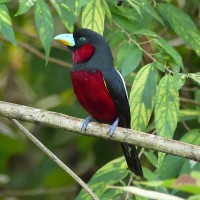 Thailand Birding & NatureFebruary 17 - March 7, 2026
Thailand Birding & NatureFebruary 17 - March 7, 2026
-
Pace & Protocols +
Photo credits: Banners: Rice Fields Scenic, Jamie Fenn, courtesy UnSplash; Oriental Pied Hornbill, Matthew Schwartz, courtesy UnSplash; Cerulean Kingfisher, Nick Upton; Green Junglefowl, Nick Upton; Oriental Pied Hornbill, Nick Upton; Indigo Flycatcher, Nick Upton; Sunda Minivet, Nick Upton; White-flanked Sunbird, Nick Upton; Malayan Banded Pitta, Nick Upton; Olive-backed Woodpecker, Nick Upton; Rice Fields, Nick Upton; Satwa Lodge, Nick Upton; Malayan Banded Pitta, Nick Upton; Olive-backed Pitta, Nick Upton; Christmas Island Frigatebird, NU; Javan Whistlingthrush, NU; Sunda Minivet, NU; White-flanked Sunbird, NU; Black-naped Fruit Dove, NU; Javan Green Peafowl, NU; Green Junglefowl, NU; Javan Banded Pitta, Nick Upton; Bali Myna, Nick Upton; White-faced Partridge; Javan Green Peafowl, Nick Upton; Banded Broadbill, Nick Upton; Banded Kingfisher, Nick Upton; Oriental Bay Owl, Nick Upton.





